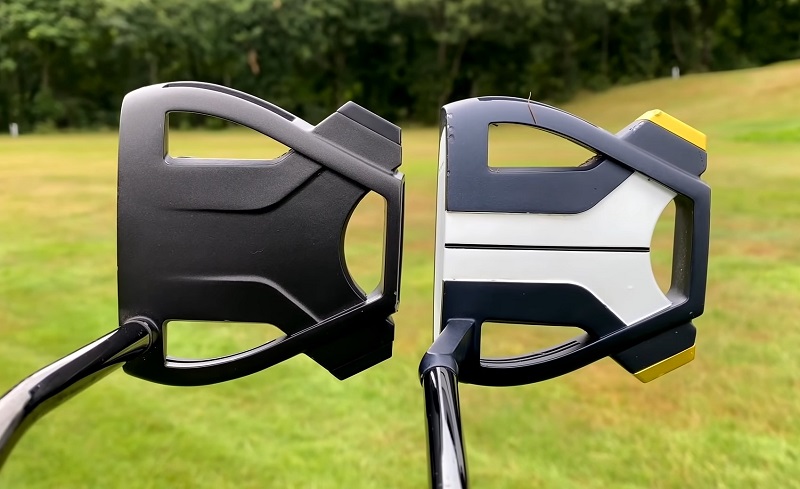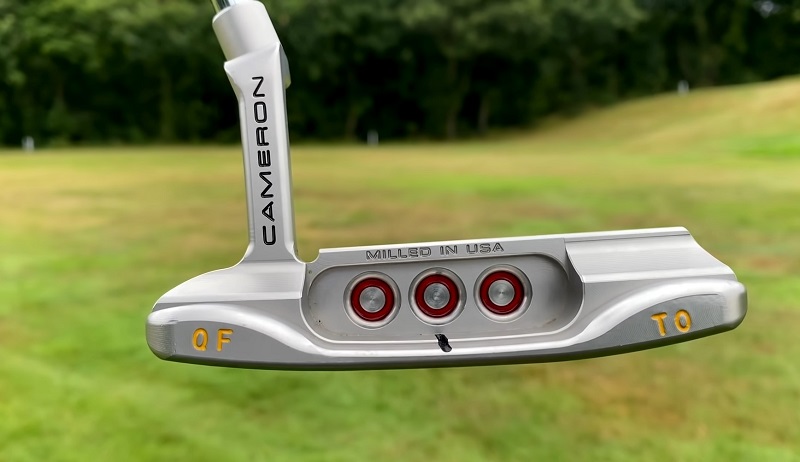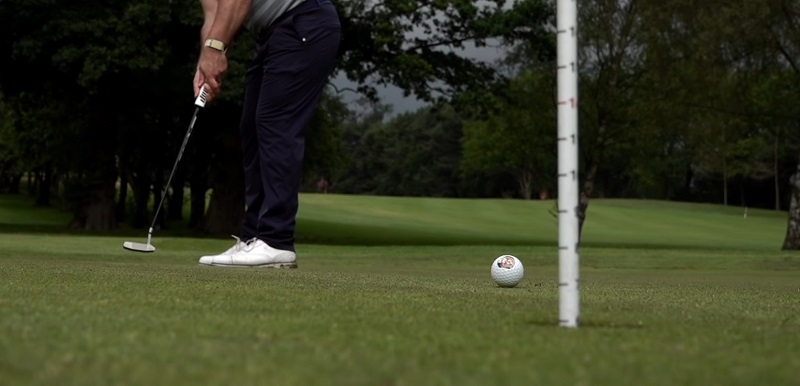Golfers of all skill levels know that choosing the right putter is crucial to improving their game on the green. With so many options available, it can be overwhelming to decide between the two most popular styles: mallet and blade putters.
Mallet putters are known for their larger and more complex head design, while blade putters feature a thin and flat blade-shaped head.
In this article, we will compare the differences between mallet vs blade putters and explore each style’s benefits and drawbacks to help you decide which putter is the better choice for your golf game.
What Is A Mallet Putter?

A mallet putter is a type of golf putter that has a larger and more complex head shape, which resembles a mallet or hammer. The head of the putter is typically made of high-density materials, such as stainless steel or aluminum, and may include a variety of weights and features designed to improve alignment, stability, and forgiveness.
Mallet putters typically have a higher moment of inertia (MOI) than blade putters, making them more stable and less prone to twisting upon impact. This can be especially beneficial for golfers who struggle with consistency on the green or who prefer a more stable putting stroke. Mallet putters come in various shapes and sizes, from traditional to futuristic designs, and can be used by golfers of all skill levels.
Pros Of Mallet Putters
- Forgiving: Mallet putters have larger heads and are more forgiving than blade putters. This means that they are more likely to reduce the impact of mishits and make it easier to achieve straighter shots.
- Alignment: The larger head of a mallet putter provides more visual cues for alignment, making it easier to line up your shot.
- Stability: The weight distribution of a mallet putter is often more evenly distributed, which provides a more stable putting stroke.
Cons Of Mallet Putters
- Distance Control: Mallet putters can be more difficult to control the distance of your putts with. This is because the larger head can make it more challenging to feel the ball on the putter face.
- Aesthetics: Mallet putters can be less aesthetically pleasing to some players. The larger head can be visually distracting for some players, which can affect their confidence in the ball.
What Is A Blade Putter?

A blade putter is a traditional style of putter that has a thin and flat blade-shaped head. The design is simple and straightforward, with a straight shaft and minimal features. The blade putter has been a popular choice for golfers for many years and is still widely used by professionals and amateurs alike.
Due to its design, the blade putter offers a softer feel and better balance, which can provide more control and precision on short putts. Blade putters also offer more feedback to the golfer on each stroke, allowing for more fine adjustments.
Pros Of Blade Putters
- Feel: Blade putters are known for providing the golfer with a better feel and feedback. This is because the smaller head size provides more direct contact with the ball, giving the player a better sense of the impact.
- Distance Control: Blade putters can offer more control over the distance of your putts, allowing you to make more precise adjustments.
- Aesthetics: Golfers often consider blade putters more aesthetically pleasing, with their sleek and simple design.
Cons Of Blade Putters
- Forgiveness: Blade putters are less forgiving than mallet putters, meaning mishits can result in a loss of distance and accuracy.
- Alignment: The smaller head size of a blade putter can make alignment more difficult for some players, as there are fewer visual cues.
Compare The Difference Between Mallet Vs Blade Putters
The mallet putter and the blade putter are two of the most popular types of putters on the market today, each with its advantages and drawbacks. When looking for a new putter, it’s important to understand the differences between mallet and blade models to determine which is right for you.
Design and Construction
The most noticeable difference between mallet and blade putters is their design and construction. Blade putters are traditional and straightforward, with a thin, flat blade-shaped head. Mallet putters, on the other hand, have a larger and more complex head that resembles a mallet or hammer. Mallet putters often have a higher moment of inertia (MOI), making them more stable and less prone to twisting upon impact.
Alignment and Forgiveness
The larger and more complex head of a mallet putter typically allows for greater alignment and forgiveness on off-center hits. Mallet putters often have a larger sweet spot, which is the optimal spot for striking the ball and can help reduce the negative effects of mis-hits. This can be especially beneficial for beginners or golfers who struggle with consistency on the green.
Feel and Balance
Blade putters are generally considered to have a softer feel and better balance, which can provide more control and precision on short putts. Blade putters also offer more feedback to the golfer on each stroke, allowing for more fine adjustments to be made. Mallet putters, on the other hand, are often favored for longer putts due to their increased stability and reduced twist upon impact.
Visual Appearance
The visual appearance of a putter can also be an important factor for some golfers. Blade putters have a traditional, classic look and are often favored by golfers who prefer a more traditional style. Mallet putters, on the other hand, have a more modern and often futuristic appearance, with a larger and more complex head.
Price
Price is another factor to consider when choosing between mallet and blade putters. Blade putters tend to be less expensive than mallet putters, as they are simpler in design and construction. Mallet putters often require more materials and technology to create, which can lead to a higher price point.
Blade Vs Mallet Putters- Which Is The Better?

The question of whether blade or mallet putters are better is a highly debated topic among golfers. The truth is that neither is inherently better, and the right choice ultimately depends on the individual golfer’s preferences and play style. Both putters have unique features, benefits, and drawbacks, which we’ll explore in more detail below.
Blade putters are often favored by golfers who prefer a softer feel and better balance, which can provide more control and precision on short putts. Blade putters also offer more feedback to the golfer on each stroke, allowing for more fine adjustments. However, blade putters can be less forgiving on mis-hits, and golfers who struggle with consistency on the green may find them less helpful.
Mallet putters, on the other hand, have larger and more complex heads. They are often favored by golfers who want greater alignment and forgiveness on off-center hits. Mallet putters often have a higher moment of inertia (MOI), making them more stable and less prone to twisting upon impact. This can be especially beneficial for beginners or golfers struggling with green consistency. However, some golfers may find the larger size and weight of mallet putters less comfortable or less conducive to their playing style.
The choice between blade and mallet putters comes from personal preference and play style. It’s important to test out both types of putters and see which one feels most comfortable and effective for your game. Many golfers even choose to have both putters in their bags and use them in different situations or on different greens. So, don’t stress too much about which putter is “better” and focus on finding the one that works best for you.
Which Professionals Use A Mallet Putter?
Many professional golfers use mallet putters on the PGA Tour. Here are a few notable examples:
Dustin Johnson: Johnson, who is currently the number one ranked golfer in the world, uses a TaylorMade Spider Tour Black mallet putter.
Jason Day: Day, a former world number one, uses a TaylorMade Spider Tour Red mallet putter.
Hideki Matsuyama: Matsuyama, a five-time PGA Tour winner, uses a Scotty Cameron by Titleist Futura X5 mallet putter.
Bryson DeChambeau: DeChambeau, the 2020 U.S. Open champion, uses a custom-made SIK Golf prototype mallet putter.
Justin Rose: Rose, a major champion and Olympic gold medalist, uses a TaylorMade Spider Tour Red mallet putter.
Which Professionals Use A Blade Putter?
Many professional golfers still use blade putters, as they are a traditional style and offer a soft feel and better control on short putts. Here are some notable professional golfers who use blade putters:
Tiger Woods – Woods has used a Scotty Cameron Newport 2 blade putter for much of his career and has won many major tournaments with it.
Rory McIlroy – McIlroy has used several different blade putters throughout his career, including a Scotty Cameron Studio Select Newport 2 and a TaylorMade Spider Tour Red.
Justin Rose – Rose has used a TaylorMade TP Collection Juno blade putter for several years and has had success on the PGA Tour with it.
Jordan Spieth – Spieth has used a Scotty Cameron 009 blade putter for much of his career and has won several major tournaments with it.
Phil Mickelson – Mickelson has used a variety of blade putters throughout his career, including a Scotty Cameron Newport 2 and an Odyssey White Hot XG #9.
What Are Some Common Mistakes To Avoid When Using A Blade Or Mallet Putter?
There are several common mistakes that golfers make when using either a blade or mallet putter. Here are a few to keep in mind:
- Grip Pressure: Grip pressure can significantly impact your putting stroke. Gripping the putter too tightly can cause tension in your hands, arms, and shoulders, leading to an inconsistent stroke. Make sure to maintain a light grip pressure throughout your stroke.
- Misaligned Putter Face: The alignment of your putter face at the address can significantly impact your accuracy. Make sure to align the putter face perpendicular to the target line to ensure you’re aiming at your target.
- Poor Weight Distribution: The weight distribution of your putter can impact your stroke’s consistency and accuracy. Make sure to find a putter with a weight and balance that feels comfortable and helps you maintain good control throughout your stroke.
- Poor Set-Up: Setting up correctly for your putt is crucial. Make sure to position the ball correctly and stand with your feet shoulder-width apart. Ensure that your eyes are positioned directly over the ball for a consistent and accurate stroke.
- Overthinking: Overthinking your putting stroke can lead to tense muscles and a lack of confidence, ultimately impacting your performance. Instead, try to focus on a simple, repeatable stroke that feels comfortable and natural.
How To Choose The Right Putter For Your Game?
No matter which type of putter you choose, there are a few key things to look for when shopping for one:
Determine your putting style: It’s important to know your putting style before choosing a putter. Are you an arc putter or a straight-back and straight-through putter? Arc putters typically benefit from a blade putter, while straight back and through putters may prefer a mallet putter.
Consider the design: As discussed earlier, blade putters have a traditional look and often offer a better feel and precision, while mallet putters have a more modern look and are often more forgiving on mis-hits. Choose the design that suits your personal preferences.
Look for the right length: The length of the putter is an important factor to consider. A putter that is too long or short can affect your posture and balance. Get fitted for a putter that is the right length for you.
Check the weight: The weight of the putter can also have an impact on your performance. A heavier putter can provide better stability and control, while a lighter putter may help with faster swing speeds.
Consider the grip: The grip is the only point of contact between you and the putter, so it’s essential to choose a grip that feels comfortable and offers enough traction for your hands.
Try before you buy: Before making a purchase, try out different putters to see which one feels the most comfortable and offers the best performance for your putting style.
Conclusion
Both mallet and blade putters have their advantages, depending on the type of golfing style one indulges in. Mallets can be more helpful in alignment and forgiveness, providing a more stable base that helps in accuracy and consistency. On the other hand, blades speak for themselves, with a classic design allowing experienced players more control over the ball. Ultimately, it comes down to preferences and what one feels comfortable with.
No matter which style a golfer decides to choose, the important thing is that he maintains the correct grip, posture, and strength while putting so that he gains maximum 5-speed ball movement, which will reduce strokes per hole. Considering all these points, however, they decide to putt – either with a mallet or blade – they can be sure this decision will only help them up their game.
FAQs
Do Pros Use Blades Or Mallet More?
Professional golfers use both blade and mallet putters on the PGA Tour, and there is no clear consensus on which type is used more frequently. Recently, there has been a trend toward using mallet putters, particularly among younger players. However, many experienced professionals still prefer a blade putter’s traditional look and feel.
Which Putter Is The Easiest To Hit?
Mallet putters are considered to be easier to hit due to their larger sweet spot and higher MOI. The larger head of a mallet putter provides greater forgiveness on off-center hits, which can be especially helpful for beginners or golfers who struggle with consistency on the green.
Can A Beginner Golfer Use A Blade Putter?
A beginner golfer can use a blade putter, but it may be more challenging due to its smaller sweet spot and less forgiveness on off-center hits. A mallet putter may be a better choice for a beginner golfer who is still developing their putting skills.
What Is The Price Range Difference Between Blade And Mallet Putters?
The price range for both blade and mallet putters can vary depending on the brand, model, and features. However, mallet putters are generally more expensive than blade putters due to their larger and more complex head design. Mallet putters can range anywhere from around $100 to $500 or more, while blade putters can range from around $50 to $400 or more.
How Do I Properly Fit A Putter To My Body And Swing?
Proper putter fitting involves finding the right length, lie angle, and grip size for your body and swing. It’s best to work with a professional club fitter or instructor to determine the correct fit for you.
Thank you for reading! We hope this article has helped you understand blade vs mallet putters and make an informed decision when shopping for one. Good luck with the course!


